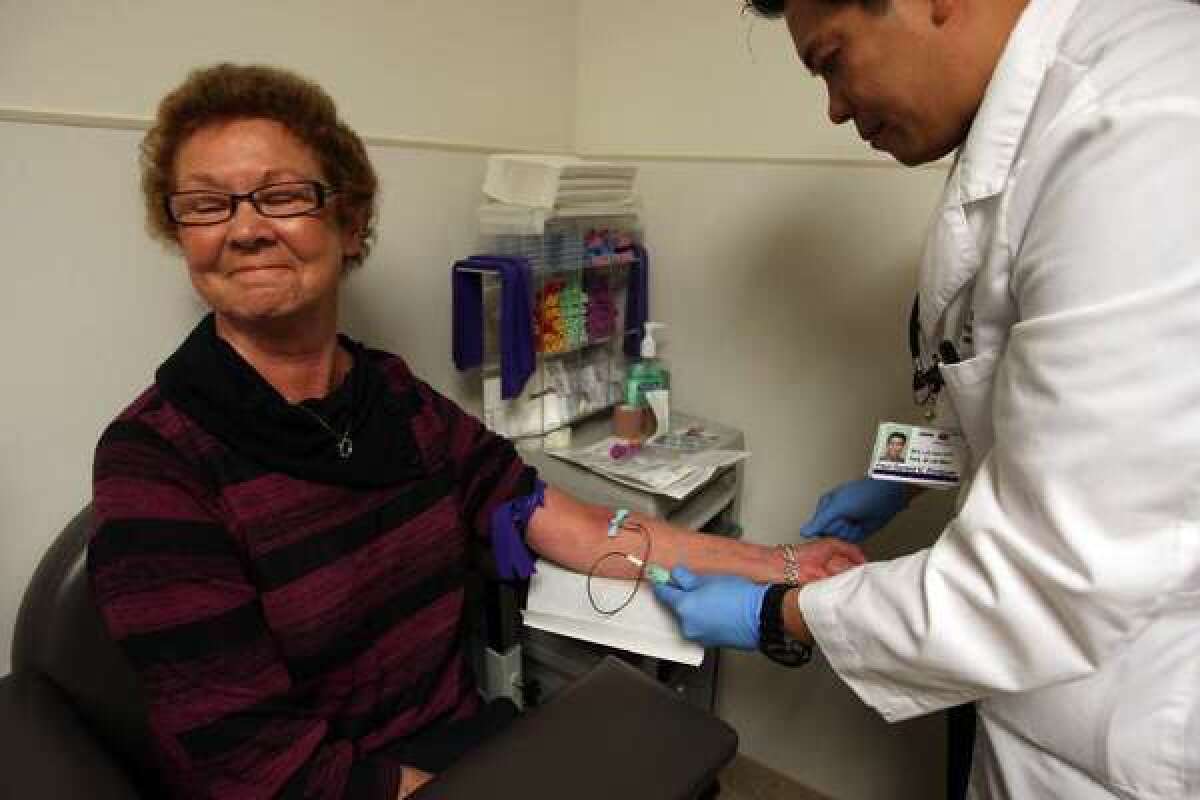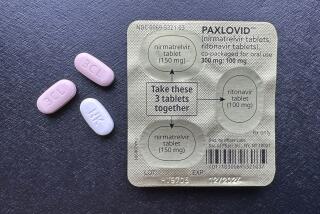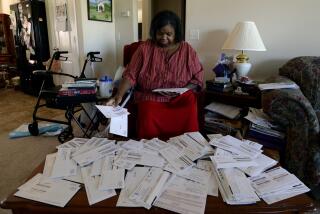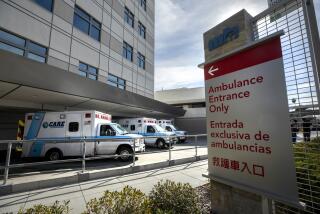Coronavirus already changing medical care in the U.S.

- Share via
WASHINGTON — The coronavirus pandemic, which has fueled widespread speculation about potential long-term changes to American life, is already causing one important shift: It has accelerated moves to restructure how basic medical care is provided and paid for in the U.S.
Doctor groups and insurers say in just the last month, there’s been a dramatic surge of interest in large-scale changes in the way primary care doctors are paid, an overhaul that policy experts have envisioned for decades.
“I’m a little amazed,” said Shawn Martin, vice president of the American Academy of Family Physicians. “The sense of urgency and financial instability brought on by the crisis has accelerated ideas that we have been noodling on for years.”
Driving the urgency is a dramatic drop-off in patient visits to primary care practices over the last month as the coronavirus spread and patients stayed away from the doctor’s office, fearful of getting ill.
Primary care doctors have seen a big uptick in telehealth visits — a move widely hailed by public health experts. However, the fees for these services are often lower than for office visits.
Many physician practices have seen in-person patient visits drop 50% or even 75%. That has left physicians struggling to stay afloat and forced growing numbers to consider laying off staff or even closing their doors.
Get our L.A. Times Politics newsletter
The latest news, analysis and insights from our politics team.
You may occasionally receive promotional content from the Los Angeles Times.
Nearly 8 in 10 primary care clinicians in one recent survey reported their practice is under “severe” or “close to severe” strain due to COVID-19, the disease caused by the coronavirus.
To deal with that problem, the federal Medicare program and some commercial health plans have begun offering advance payments to medical providers, effectively giving physicians a lump sum based on an estimate of how much they would expect to collect from seeing a normal stream of patients.
Many experts in the healthcare system see that as a first step toward redefining the traditional office visit, expanding telehealth and abandoning the age-old system of paying doctors for each service they perform.
That would mark one of the first clear examples of how the coronavirus outbreak — and the gaps it has exposed — may catalyze profound changes in the healthcare system.
“To date, we’ve been taking only small steps,” said Ann Greiner, head of the Primary Care Collaborative, a leading advocate for changing how primary care is financed and organized. “The pandemic has exposed how weak the system is and the peril that represents for all of us.”
Overhauling how America’s primary care physicians — including internists, family doctors and pediatricians — do their jobs is a large undertaking. It involves billions of dollars paid by government, large employers and commercial health insurers. Discussions about such an overhaul are only just beginning.
But the intense financial problems hitting primary care practices have driven the discussions forward even as the strain on practices has alarmed public health advocates.
Primary care offices are best positioned to keep patients out of hospitals and reduce demand on medical centers already strained by the pandemic. And the struggles many doctors currently face have raised fears of a broader collapse of the nation’s primary-care system. That could drive up costs long into the future if Americans must seek medical care in expensive hospital systems.
“This is a crisis,” said Elizabeth Mitchell, head of the Pacific Business Group on Health, a consortium of large companies including Boeing, Safeway, Walmart and Wells Fargo that for years have worked to rein in healthcare costs.
“If we don’t act, small, independent practices are going to go out of business,” Mitchell warned.
Beyond the steps that have already been taken, advocates for primary care have suggested that Medicare pay practices a fixed fee of $50 every month for every Medicare patient the practice has as a simple way to keep doctors’ offices open.
Normally, doctors are paid through what’s known as a fee-for-service arrangement, in which they bill for each office visit and each procedure.
Experts have long argued this system creates the wrong incentives, forcing physicians to scramble to squeeze in as many office visits as they can, rather than thinking more about what services would deliver the best results for patients.
For example, telephone or email consultations may be more convenient and allow doctors and patients to remain in closer contact and better manage chronic illnesses such as diabetes.
A fee-for-service system gives doctors little incentive to switch to more telehealth, since they could bill less for the service.
A single monthly payment, on the other hand, can encourage physician practices to redesign the way they deliver care.
These practices can make more use of telehealth or use more health coaches, nurses and other non-physicians to deliver services such as helping diabetics change their diets and better manage their blood sugar.
“We know we have to pay differently for primary care,” Mitchell said. “And we know it works.”
Alternatives to fee-for-service already exist in some parts of the system. Certain commercial Medicare Advantage plans, for example, pay some doctors lump sums, often tied to quality targets. For years, they have achieved lower costs and better outcomes for patients than traditional physician practices.
Many doctors and health insurers, however, have been reluctant to abandon the traditional fee-for-service system.
“Physicians don’t love change,” conceded Dr. Christopher Crow, president of Catalyst Health Network, which helps about 800 Texas primary care physicians manage their patients.
But Crow is now among a group of physician leaders across the country pressing health plans to move rapidly toward lump-sum payments to doctors.
He and others concede that many details must still be worked out, including how fixed payments to primary physicians would be calculated.
Payments need to be sufficient to allow primary care practices to effectively manage their patients’ health, advocates say. But Crow and others stress that the stakes for primary care couldn’t be higher right now.
“The coronavirus crisis has highlighted the importance of hospitals,” said Melinda Abrams, senior vice president of the Commonwealth Fund, a nonprofit foundation that researches health systems. “But what has also become clear is the increasing importance of a robust, comprehensive primary care system that can help patients avoid hospitals in the first place.”
More to Read
Get the L.A. Times Politics newsletter
Deeply reported insights into legislation, politics and policy from Sacramento, Washington and beyond. In your inbox twice per week.
You may occasionally receive promotional content from the Los Angeles Times.











